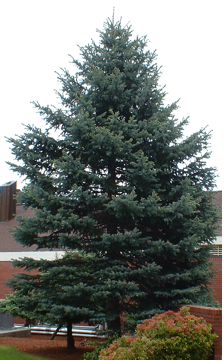The Sitka Spruce
 |
 |
 |
Tag Number: 420
Scientific Name: Picea sitchensis
Picea is derived from pix, meaning pitch, since the resin from the trees was used to make pitch before synthetic materials were available
Common Names
- Coast Spruce
- Sitka Spruce
- Tideland Spruce
Habitat
Naturally found along the coastline in Alaska, British Columbia, Washington, Oregon, and California.
Morphology
Needles on the top of the twig point forward. Side needles are nearly perpendicular to the twigs.
History
The Sitka Spruce gets its name from an Alaskan island called Baranof Island, because it was once called Sitka Island. Alaska is the largest state in the United States, and the Sitka is the largest spruce in the world; fittingly, it is the state tree of Alaska. The wood is very light and very strong. Resultantly, it is used in ladders, garage doors, and folding bleachers. It also reverberates well and is used in instruments like pianos and violins.
Ethnobotany
Although all spruces have sharp needles, those of the Sitka Spruce are the sharpest and most rigid of any tree in the northwest. Aboriginal people believed it could protect them from evil thoughts, and the Ditidaht utilized its powers in ceremonies to protect the dancers. Young roots were removed and singed in the fire to prevent them from stiffening, so they could be used in baskets and hats by the Haida. They also consumed the inner bark plain or with berries. Interstingly, this same bark was consumed by the Nuxálk of British Columbia as a laxative. Other edibles include the shoots, which are high in vitamin C and enjoyed by the Makah of Washington, and the resin, which was used as a chewing gum. The resin was further used to relieve skin irritants such as slivers and burns and used medicinally in the treatment of colds, toothaches, syphilis, and gonorrhea.


